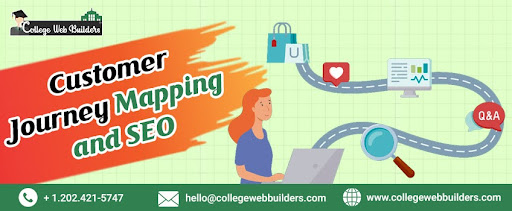
Customer Journey Mapping and SEO
Customer journey mapping is a technique where a customer's entire process of getting through a certain phase, depending on the brand's awareness of where they buy a product, is depicted. Combined with SEO, it assists businesses in attaining optimization for both search engine results and the human senses in developing valuable and attractive content for customers at different stages. Hence, our Search Engine Marketing Company, Ashburn USA, is here to understand customer journey mapping, its connection to SEO, and how to optimize them for the business.
What is Customer Journey Mapping?
Customer journey maps are the exact diagrams or graphical illustrations of a customer's path through a brand or an organization. As per any content marketing services company in Ashburn Virginia, it normally consists of the following levels: awareness, consideration, decision, and loyalty. Each stage is linked with touchpoints and emotions that make it easier for businesses to grasp the whole process from the customer's perspective. By leveraging customer journey mapping, companies can answer questions such as:
- How does the brand introduction take place?
- Can you identify their main requirements and problems to solve at each stage?
- What steps or sources are required to further progress towards the journey?
Through mapping, customer needs, uses, and gains are learned and then business strategies that meet customer needs in various phases are developed.
Stages of the Customer Journey
Consideration: The customer has understood the need or problem that they have and starts to compare the possible solutions.
Analysis: The customer gathers information about the competitors and analyzes alternatives and possibilities.
Purchase decision: The customer selects a brand or product and goes ahead to buy the particular brand.
Repeat business: After the sale, the brand tries to capture the customer's loyalty for future business.
Word of Mouth: A highly satisfied customer is a spokesman for that brand and carries around a message recommending the brand.
SEO and the Customer Journey
SEO is essential to each step in the customer cycle to help brands properly target the consumers they wish to interact with and sell their products or services. It is essential to target the right keywords and use them in content, answer people's questions, and create great resources as part of the SEO strategy provided by SEO consulting focused on the customer.
How SEO Enhances the Customer Journey
Each stage of the journey has unique SEO considerations, as user search intent changes as they progress through the funnel:
Awareness Stage SEO: The customer's query may be as simple as "How do I solve this issue?" or "What is this." At this stage, the content should provide information that helps the reader and makes the reader turn to the brand as a source of information. For instance, under the header, the health brand can develop an article titled "10 Natural ways to improve your sleep." Thus, it will attract users with sleep concerns, not detailed brand knowledge.
Consideration Stage SEO: Here, customers are aware of their problem and are searching for a solution. They frequently implement search queries such as "top-rated mattresses for the environment" or "Which is preferable, organic mattresses or memory foam?" Texts published at this stage should speak about the product's advantages and its comparison with competitors' goods, telling more about certain cases to establish trust and provide the potential buyer with necessary instructions for further detailed analysis.
Decision Stage SEO: Customers may perform more specific searches with keywords created from noun phrases like - "Eco-friendly mattress" or "Eco-friendly mattress free delivery." Here, the product pages, user reviews, and satisfactory conversion call-to-actions matter a lot to take the search traffic. Local SEO and working on optimized landing pages using keywords that target conversion are also quite helpful.
Loyalty Stage SEO: During the post-purchase phase, the customer may type keywords such as 'how to wash an eco-friendly mattress.' This content should assure customers of what they are buying and foster a continued business relationship by offering them further assistance through other useful resources, frequently asked questions and support.
Advocacy Stage SEO: When the customer is satisfied, they will post feedback and, in the process, look for means to sponsor the brand. To optimize this, businesses can develop a referral scheme and encourage people to leave good comments on social media platforms or review websites, which will work towards creating good 'word of mouth' impacts rather than the impact created by creating backlinks for SEO improvement.
Drawing Relationship between Customer Journey Mapping and SEO Plans
To get the most out of this idea of mutually integrating CJM and SEO, the businesses should develop a plan to match the content with the stages in the customer journey and SEO goals.
Define Buyer Personas: To this end, the demographics, motivations, and needs of target customers allow the crafting of content that will directly address the concerns of the targeted population. The buyer personas are used for determining the tenor, the manner, and the structure of the content, and they support the SEO keywords.
Identify Customer Pain Points and Keywords: Each journey station matches certain pain points and questions. It is crucial to find out what keyword customers are typing at each stage to ensure that content for blogging and SEO are planned to meet customer expectations.
Map Content to the Customer Journey: Group material according to the journey stages and analyze whether there are any gaps. Ensure that the pieces' contents are properly keyworded and have a specific strong guide to lead the user through every stage.
Optimize Technical SEO: It takes much more than keywords to achieve good SEO - it is about the overall user experience on the website. Optimization factors such as pace of page loading, mobile responsiveness, security HTTPS, and structured data are some of the SEO parameters that are standard today and which make a big difference in ranking and experience – especially in the decision stage where a user expects fast and reliable content.
Monitor and Adjust Based on Analytics: Customers' behavior may always change and, therefore, often assess other engagement parameters such as bounce rates, session length, and conversion rate for each journey phase. Based on this data, some changes are made to the content plan and the focus on SEO, and the journey map is updated.
Conclusion
Customer journey mapping and SEO are two strategies with a significant intersection that forms a user-focused approach to address digital marketing. Moreover, by identifying these stages and tailoring SEO best practices with each of them, enterprises can improve serialized content that captures high rankings and is relevant to and informs the customers. Aside from delivering organic traffic this also builds meaningful relationships with the customers, thereby increasing the conversion rate, sticking to the brand, and thus the business. For more information or email marketing services in Ashburn, USA, visit Collegewebbuilders.com.
- Tags: Marketing, Onlline, Internet





